Business Strategy Report: An Analysis of Vodafone's Strategic Position
VerifiedAdded on 2020/10/22
|20
|4224
|155
Report
AI Summary
This report provides a comprehensive analysis of Vodafone's business strategy, focusing on the external and internal environments impacting its operations. It begins with a PESTLE analysis to evaluate political, economic, social, technological, legal, and environmental factors influencing Vodafone's growth and sustainability in the UK telecommunications market. The Ansoff's Growth vector matrix is then employed to assess Vodafone's strategic position, examining market penetration, product development, market development, and diversification strategies. The report further delves into the internal environment, defining strategic capabilities and utilizing the VRIO framework to determine the value, rareness, imitability, and organization of Vodafone's resources. A SWOT analysis identifies the company's strengths and weaknesses, providing a holistic view of its competitive advantages and areas for improvement. The report concludes with an analysis of the telecommunication sector and an interpretation of strategic direction using Bowman's Strategy clock model.

BUSINESS STRATEGY
Page 1 of 21
Page 1 of 21
Paraphrase This Document
Need a fresh take? Get an instant paraphrase of this document with our AI Paraphraser
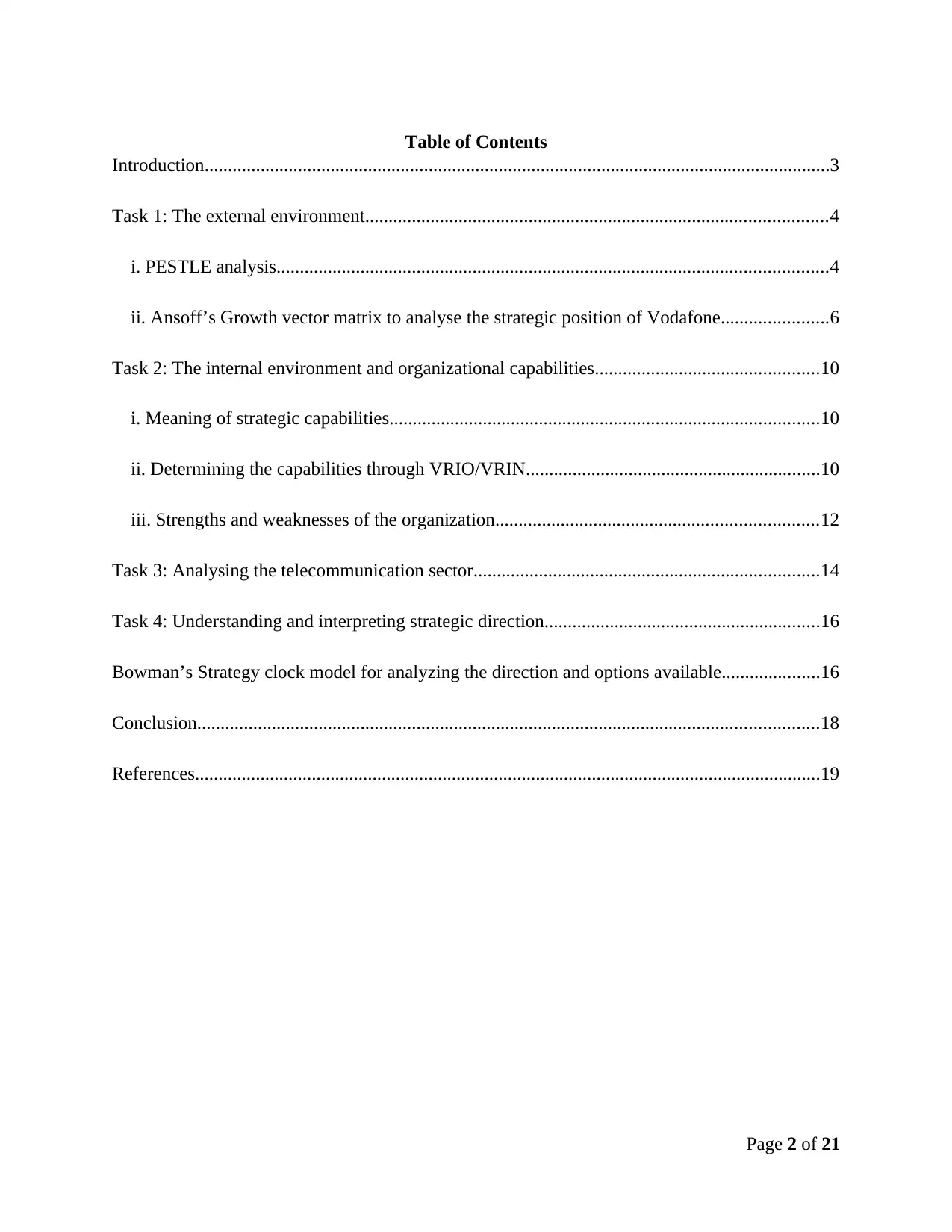
Table of Contents
Introduction......................................................................................................................................3
Task 1: The external environment...................................................................................................4
i. PESTLE analysis......................................................................................................................4
ii. Ansoff’s Growth vector matrix to analyse the strategic position of Vodafone.......................6
Task 2: The internal environment and organizational capabilities................................................10
i. Meaning of strategic capabilities............................................................................................10
ii. Determining the capabilities through VRIO/VRIN...............................................................10
iii. Strengths and weaknesses of the organization.....................................................................12
Task 3: Analysing the telecommunication sector..........................................................................14
Task 4: Understanding and interpreting strategic direction...........................................................16
Bowman’s Strategy clock model for analyzing the direction and options available.....................16
Conclusion.....................................................................................................................................18
References......................................................................................................................................19
Page 2 of 21
Introduction......................................................................................................................................3
Task 1: The external environment...................................................................................................4
i. PESTLE analysis......................................................................................................................4
ii. Ansoff’s Growth vector matrix to analyse the strategic position of Vodafone.......................6
Task 2: The internal environment and organizational capabilities................................................10
i. Meaning of strategic capabilities............................................................................................10
ii. Determining the capabilities through VRIO/VRIN...............................................................10
iii. Strengths and weaknesses of the organization.....................................................................12
Task 3: Analysing the telecommunication sector..........................................................................14
Task 4: Understanding and interpreting strategic direction...........................................................16
Bowman’s Strategy clock model for analyzing the direction and options available.....................16
Conclusion.....................................................................................................................................18
References......................................................................................................................................19
Page 2 of 21
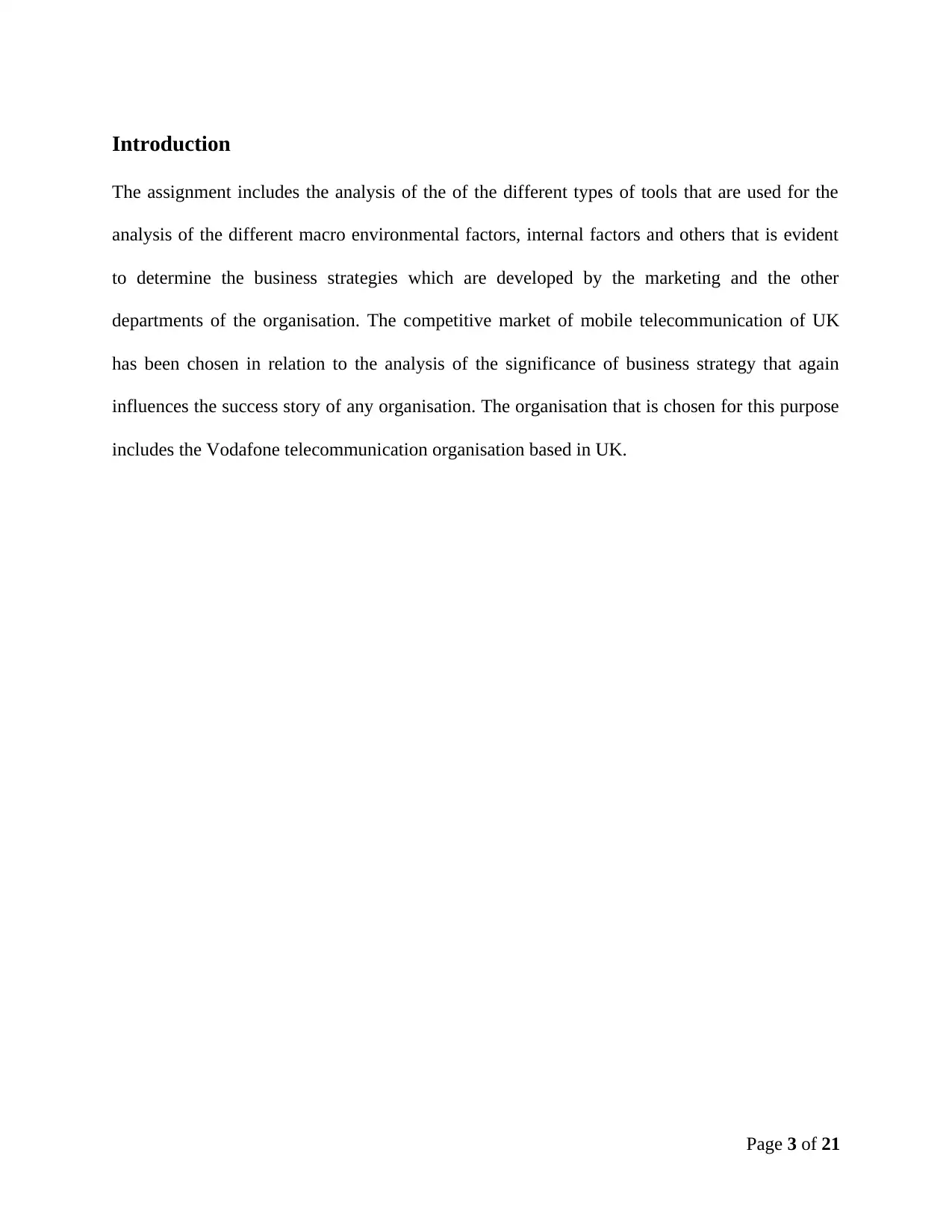
Introduction
The assignment includes the analysis of the of the different types of tools that are used for the
analysis of the different macro environmental factors, internal factors and others that is evident
to determine the business strategies which are developed by the marketing and the other
departments of the organisation. The competitive market of mobile telecommunication of UK
has been chosen in relation to the analysis of the significance of business strategy that again
influences the success story of any organisation. The organisation that is chosen for this purpose
includes the Vodafone telecommunication organisation based in UK.
Page 3 of 21
The assignment includes the analysis of the of the different types of tools that are used for the
analysis of the different macro environmental factors, internal factors and others that is evident
to determine the business strategies which are developed by the marketing and the other
departments of the organisation. The competitive market of mobile telecommunication of UK
has been chosen in relation to the analysis of the significance of business strategy that again
influences the success story of any organisation. The organisation that is chosen for this purpose
includes the Vodafone telecommunication organisation based in UK.
Page 3 of 21
⊘ This is a preview!⊘
Do you want full access?
Subscribe today to unlock all pages.

Trusted by 1+ million students worldwide
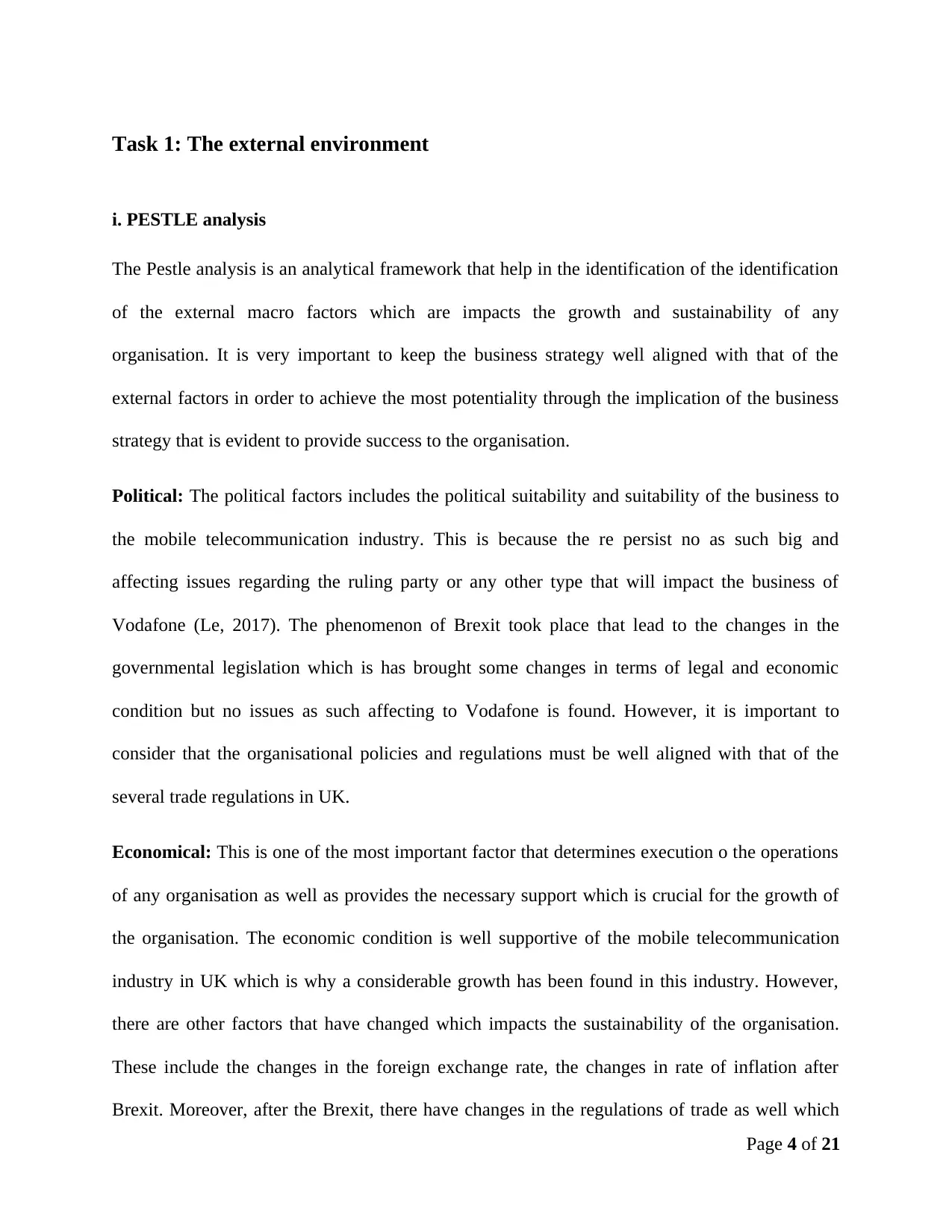
Task 1: The external environment
i. PESTLE analysis
The Pestle analysis is an analytical framework that help in the identification of the identification
of the external macro factors which are impacts the growth and sustainability of any
organisation. It is very important to keep the business strategy well aligned with that of the
external factors in order to achieve the most potentiality through the implication of the business
strategy that is evident to provide success to the organisation.
Political: The political factors includes the political suitability and suitability of the business to
the mobile telecommunication industry. This is because the re persist no as such big and
affecting issues regarding the ruling party or any other type that will impact the business of
Vodafone (Le, 2017). The phenomenon of Brexit took place that lead to the changes in the
governmental legislation which is has brought some changes in terms of legal and economic
condition but no issues as such affecting to Vodafone is found. However, it is important to
consider that the organisational policies and regulations must be well aligned with that of the
several trade regulations in UK.
Economical: This is one of the most important factor that determines execution o the operations
of any organisation as well as provides the necessary support which is crucial for the growth of
the organisation. The economic condition is well supportive of the mobile telecommunication
industry in UK which is why a considerable growth has been found in this industry. However,
there are other factors that have changed which impacts the sustainability of the organisation.
These include the changes in the foreign exchange rate, the changes in rate of inflation after
Brexit. Moreover, after the Brexit, there have changes in the regulations of trade as well which
Page 4 of 21
i. PESTLE analysis
The Pestle analysis is an analytical framework that help in the identification of the identification
of the external macro factors which are impacts the growth and sustainability of any
organisation. It is very important to keep the business strategy well aligned with that of the
external factors in order to achieve the most potentiality through the implication of the business
strategy that is evident to provide success to the organisation.
Political: The political factors includes the political suitability and suitability of the business to
the mobile telecommunication industry. This is because the re persist no as such big and
affecting issues regarding the ruling party or any other type that will impact the business of
Vodafone (Le, 2017). The phenomenon of Brexit took place that lead to the changes in the
governmental legislation which is has brought some changes in terms of legal and economic
condition but no issues as such affecting to Vodafone is found. However, it is important to
consider that the organisational policies and regulations must be well aligned with that of the
several trade regulations in UK.
Economical: This is one of the most important factor that determines execution o the operations
of any organisation as well as provides the necessary support which is crucial for the growth of
the organisation. The economic condition is well supportive of the mobile telecommunication
industry in UK which is why a considerable growth has been found in this industry. However,
there are other factors that have changed which impacts the sustainability of the organisation.
These include the changes in the foreign exchange rate, the changes in rate of inflation after
Brexit. Moreover, after the Brexit, there have changes in the regulations of trade as well which
Page 4 of 21
Paraphrase This Document
Need a fresh take? Get an instant paraphrase of this document with our AI Paraphraser
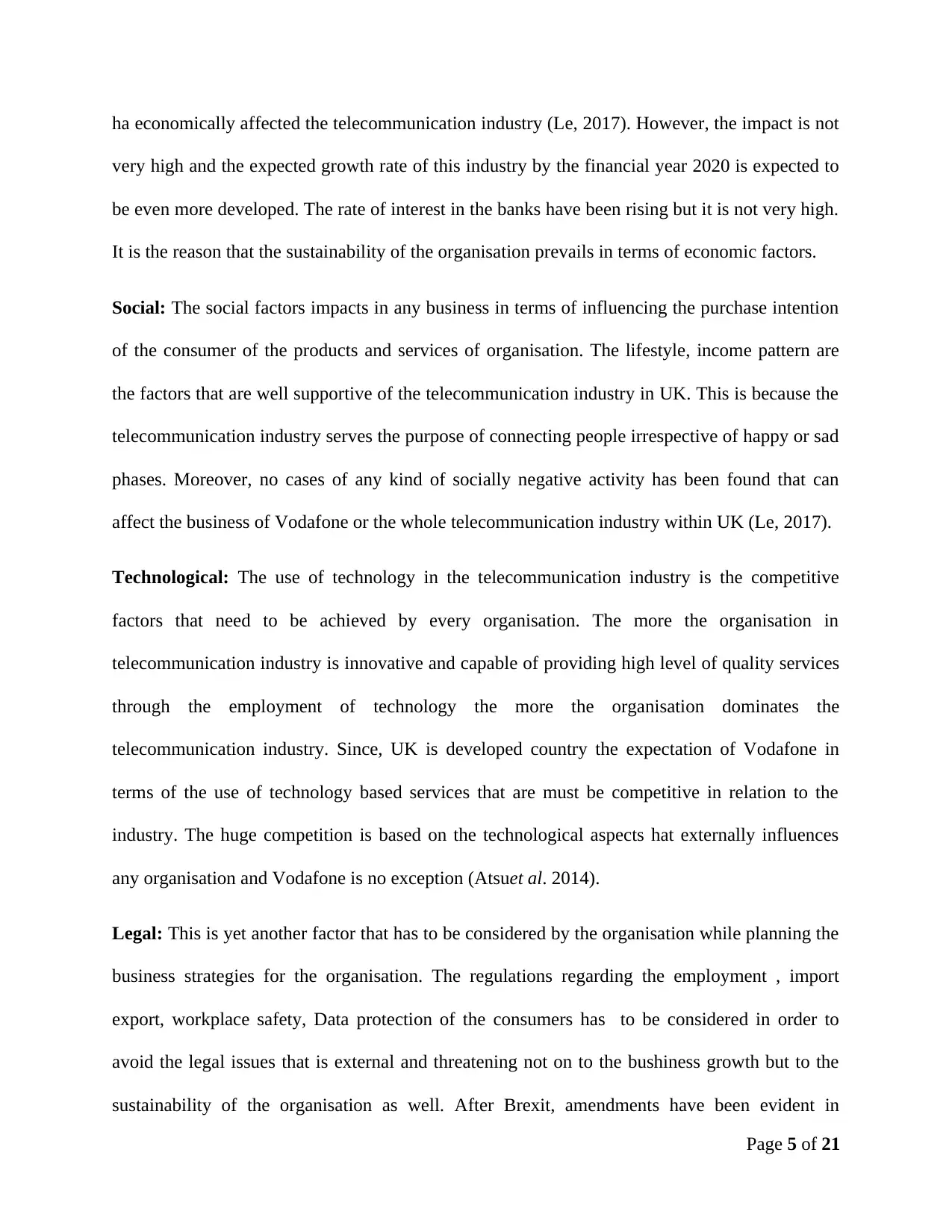
ha economically affected the telecommunication industry (Le, 2017). However, the impact is not
very high and the expected growth rate of this industry by the financial year 2020 is expected to
be even more developed. The rate of interest in the banks have been rising but it is not very high.
It is the reason that the sustainability of the organisation prevails in terms of economic factors.
Social: The social factors impacts in any business in terms of influencing the purchase intention
of the consumer of the products and services of organisation. The lifestyle, income pattern are
the factors that are well supportive of the telecommunication industry in UK. This is because the
telecommunication industry serves the purpose of connecting people irrespective of happy or sad
phases. Moreover, no cases of any kind of socially negative activity has been found that can
affect the business of Vodafone or the whole telecommunication industry within UK (Le, 2017).
Technological: The use of technology in the telecommunication industry is the competitive
factors that need to be achieved by every organisation. The more the organisation in
telecommunication industry is innovative and capable of providing high level of quality services
through the employment of technology the more the organisation dominates the
telecommunication industry. Since, UK is developed country the expectation of Vodafone in
terms of the use of technology based services that are must be competitive in relation to the
industry. The huge competition is based on the technological aspects hat externally influences
any organisation and Vodafone is no exception (Atsuet al. 2014).
Legal: This is yet another factor that has to be considered by the organisation while planning the
business strategies for the organisation. The regulations regarding the employment , import
export, workplace safety, Data protection of the consumers has to be considered in order to
avoid the legal issues that is external and threatening not on to the bushiness growth but to the
sustainability of the organisation as well. After Brexit, amendments have been evident in
Page 5 of 21
very high and the expected growth rate of this industry by the financial year 2020 is expected to
be even more developed. The rate of interest in the banks have been rising but it is not very high.
It is the reason that the sustainability of the organisation prevails in terms of economic factors.
Social: The social factors impacts in any business in terms of influencing the purchase intention
of the consumer of the products and services of organisation. The lifestyle, income pattern are
the factors that are well supportive of the telecommunication industry in UK. This is because the
telecommunication industry serves the purpose of connecting people irrespective of happy or sad
phases. Moreover, no cases of any kind of socially negative activity has been found that can
affect the business of Vodafone or the whole telecommunication industry within UK (Le, 2017).
Technological: The use of technology in the telecommunication industry is the competitive
factors that need to be achieved by every organisation. The more the organisation in
telecommunication industry is innovative and capable of providing high level of quality services
through the employment of technology the more the organisation dominates the
telecommunication industry. Since, UK is developed country the expectation of Vodafone in
terms of the use of technology based services that are must be competitive in relation to the
industry. The huge competition is based on the technological aspects hat externally influences
any organisation and Vodafone is no exception (Atsuet al. 2014).
Legal: This is yet another factor that has to be considered by the organisation while planning the
business strategies for the organisation. The regulations regarding the employment , import
export, workplace safety, Data protection of the consumers has to be considered in order to
avoid the legal issues that is external and threatening not on to the bushiness growth but to the
sustainability of the organisation as well. After Brexit, amendments have been evident in
Page 5 of 21

legislation and legal system of the organisation that has facilitate changes in the business world
as well (Atsuet al. 2014). As per the changes the organisation needs to go for the improvisations
within the organisational policies and business relations as well.
Environmental: The environmental awareness has led to yet another impacting external factors
which mandates that the business operations of the companies and the organisations has to be
equipped in relation to minimize or reduce the execution of the operations that may impact the
environment of the country or globally. There are different regulations and standards set by the
UK government which has to be followed by the telecommunication industry since, the operation
may affect the environment (Atsuet al. 2014). These have to be standardized within the
organisation so that the company does not face any challenge which is potential of marrying the
reputation of the organisation as well.
ii. Ansoff’s Growth vector matrix to analyse the strategic position of Vodafone
In order to analyse the strategic position of the Vodafone, the Ansoff’s Growth matrix is
employed for the identification of the different ways through which the organisation is going to
identify the growth factors as per which the marketing department of the organisation can device
new plans in relation to the four factors of growth. The following factors are presented hereafter
in terms and table and further analysed:
Existing product New product
Existing market Market Penetration Product development
New market Market Development Diversification
Page 6 of 21
as well (Atsuet al. 2014). As per the changes the organisation needs to go for the improvisations
within the organisational policies and business relations as well.
Environmental: The environmental awareness has led to yet another impacting external factors
which mandates that the business operations of the companies and the organisations has to be
equipped in relation to minimize or reduce the execution of the operations that may impact the
environment of the country or globally. There are different regulations and standards set by the
UK government which has to be followed by the telecommunication industry since, the operation
may affect the environment (Atsuet al. 2014). These have to be standardized within the
organisation so that the company does not face any challenge which is potential of marrying the
reputation of the organisation as well.
ii. Ansoff’s Growth vector matrix to analyse the strategic position of Vodafone
In order to analyse the strategic position of the Vodafone, the Ansoff’s Growth matrix is
employed for the identification of the different ways through which the organisation is going to
identify the growth factors as per which the marketing department of the organisation can device
new plans in relation to the four factors of growth. The following factors are presented hereafter
in terms and table and further analysed:
Existing product New product
Existing market Market Penetration Product development
New market Market Development Diversification
Page 6 of 21
⊘ This is a preview!⊘
Do you want full access?
Subscribe today to unlock all pages.

Trusted by 1+ million students worldwide
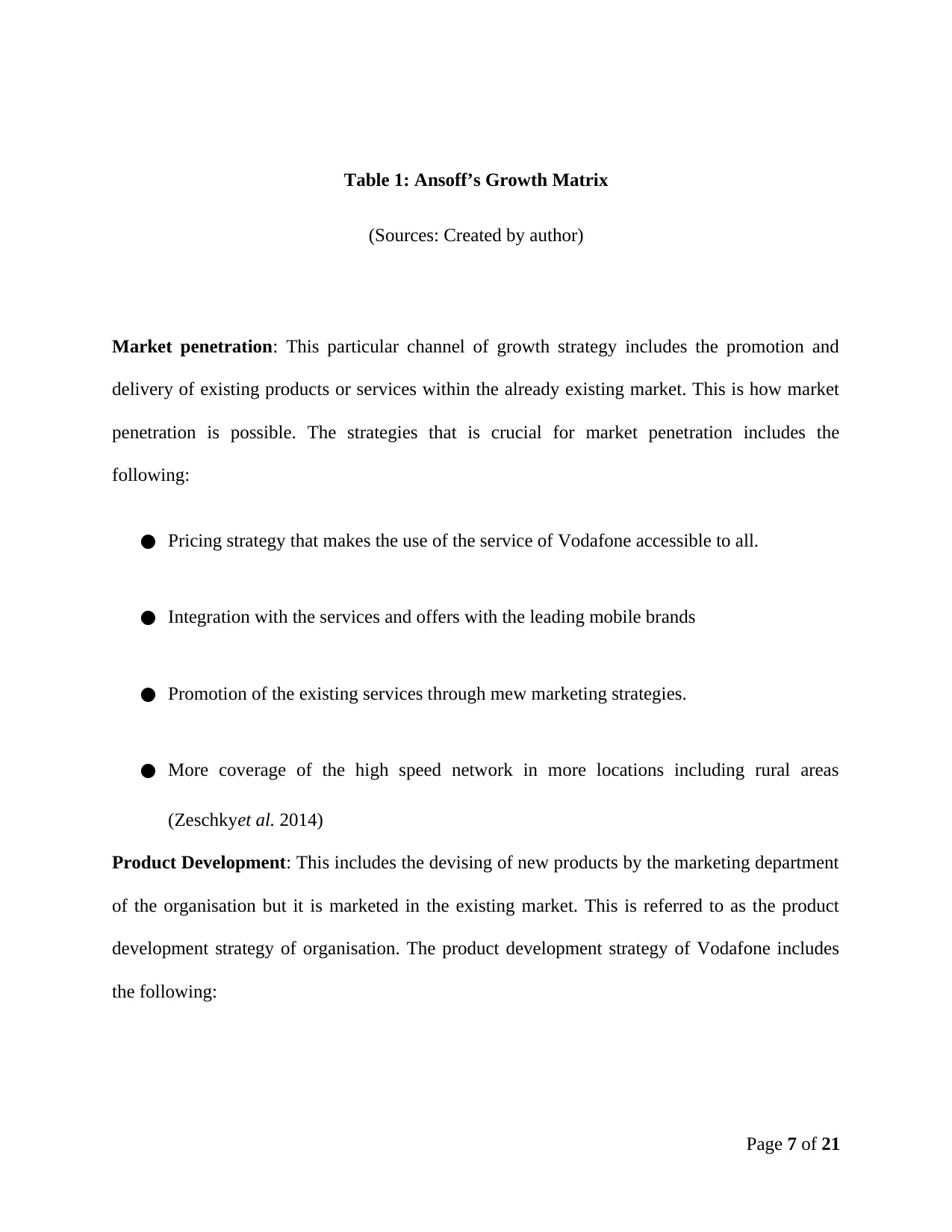
Table 1: Ansoff’s Growth Matrix
(Sources: Created by author)
Market penetration: This particular channel of growth strategy includes the promotion and
delivery of existing products or services within the already existing market. This is how market
penetration is possible. The strategies that is crucial for market penetration includes the
following:
● Pricing strategy that makes the use of the service of Vodafone accessible to all.
● Integration with the services and offers with the leading mobile brands
● Promotion of the existing services through mew marketing strategies.
● More coverage of the high speed network in more locations including rural areas
(Zeschkyet al. 2014)
Product Development: This includes the devising of new products by the marketing department
of the organisation but it is marketed in the existing market. This is referred to as the product
development strategy of organisation. The product development strategy of Vodafone includes
the following:
Page 7 of 21
(Sources: Created by author)
Market penetration: This particular channel of growth strategy includes the promotion and
delivery of existing products or services within the already existing market. This is how market
penetration is possible. The strategies that is crucial for market penetration includes the
following:
● Pricing strategy that makes the use of the service of Vodafone accessible to all.
● Integration with the services and offers with the leading mobile brands
● Promotion of the existing services through mew marketing strategies.
● More coverage of the high speed network in more locations including rural areas
(Zeschkyet al. 2014)
Product Development: This includes the devising of new products by the marketing department
of the organisation but it is marketed in the existing market. This is referred to as the product
development strategy of organisation. The product development strategy of Vodafone includes
the following:
Page 7 of 21
Paraphrase This Document
Need a fresh take? Get an instant paraphrase of this document with our AI Paraphraser

● The first and foremost strategy that is crucial for the growth of the organisation includes
the introduction of 4G connection and service provider in which the organisation
pioneered in UK.
● The organisation has to offer convenience in recharging and payment that are hassle free
like that of online payments (Zeschkyet al. 2014)
● Smart connection gadgets or services is introduced that is crucial for product
development which may include 4G station mobile, Wi-Fi and others
● Developing new mobile applications that enhances the customers’ satisfaction in using
the service. For instance, NFRC and others if any.
● Integrating the services and the various newly developed routes is yet another factor that
are remarkable product development (Zeschkyet al. 2014).
Market Development: The market development is done through the introduction of the existing
products that is introduced in the new market where the products or services were not marketed
earlier. The factors that are crucial for the market development of the organisation includes the
following:
● The locations in UK that are yet deprived of internet connection like the rural locations of
UK. This is going to be a potential market of the organisation.
● The existing products like that of the Vodafone Web box, M-Peda must be introduced to
the new markets where these are not available or not provided by any other organisation
(Bonelli, 2017).
Page 8 of 21
the introduction of 4G connection and service provider in which the organisation
pioneered in UK.
● The organisation has to offer convenience in recharging and payment that are hassle free
like that of online payments (Zeschkyet al. 2014)
● Smart connection gadgets or services is introduced that is crucial for product
development which may include 4G station mobile, Wi-Fi and others
● Developing new mobile applications that enhances the customers’ satisfaction in using
the service. For instance, NFRC and others if any.
● Integrating the services and the various newly developed routes is yet another factor that
are remarkable product development (Zeschkyet al. 2014).
Market Development: The market development is done through the introduction of the existing
products that is introduced in the new market where the products or services were not marketed
earlier. The factors that are crucial for the market development of the organisation includes the
following:
● The locations in UK that are yet deprived of internet connection like the rural locations of
UK. This is going to be a potential market of the organisation.
● The existing products like that of the Vodafone Web box, M-Peda must be introduced to
the new markets where these are not available or not provided by any other organisation
(Bonelli, 2017).
Page 8 of 21
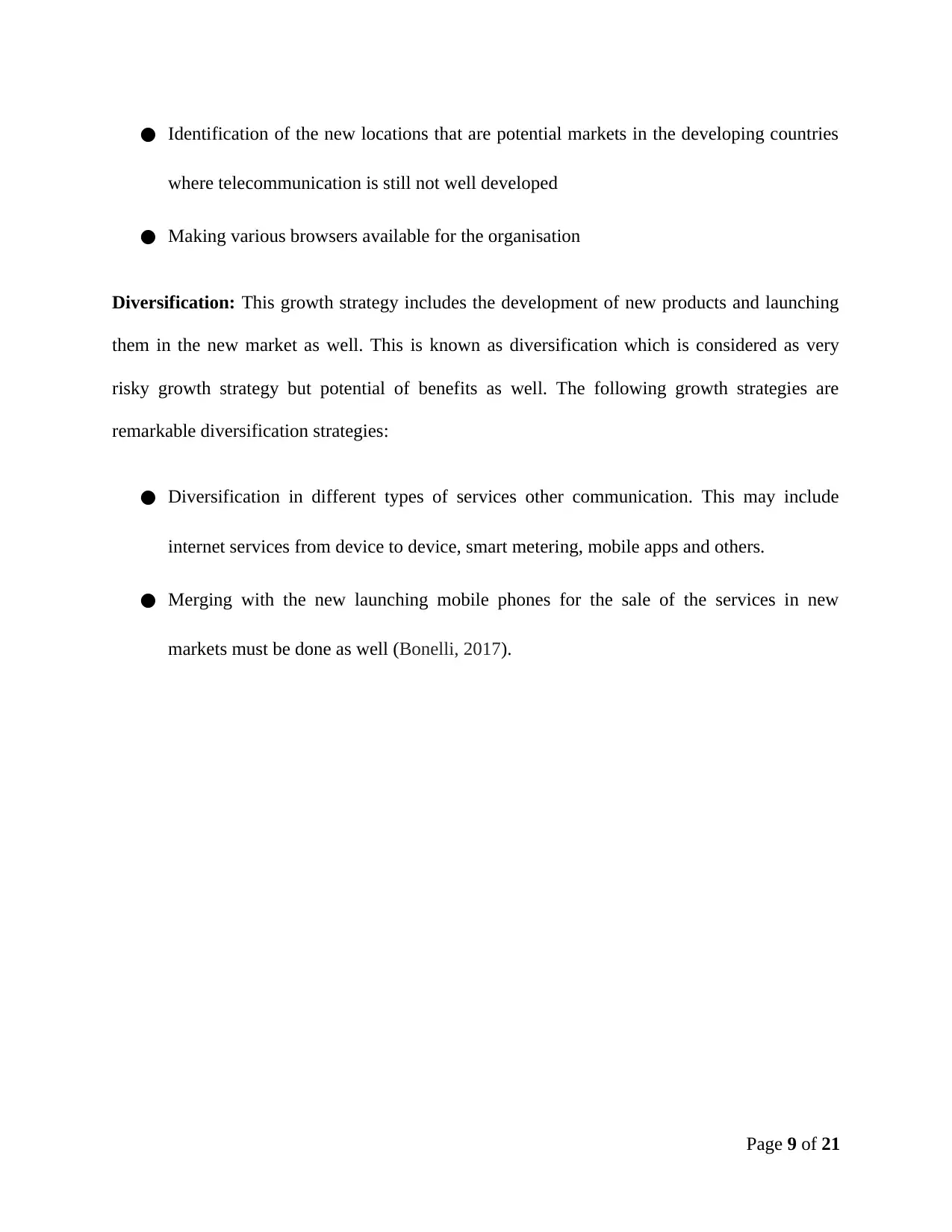
● Identification of the new locations that are potential markets in the developing countries
where telecommunication is still not well developed
● Making various browsers available for the organisation
Diversification: This growth strategy includes the development of new products and launching
them in the new market as well. This is known as diversification which is considered as very
risky growth strategy but potential of benefits as well. The following growth strategies are
remarkable diversification strategies:
● Diversification in different types of services other communication. This may include
internet services from device to device, smart metering, mobile apps and others.
● Merging with the new launching mobile phones for the sale of the services in new
markets must be done as well (Bonelli, 2017).
Page 9 of 21
where telecommunication is still not well developed
● Making various browsers available for the organisation
Diversification: This growth strategy includes the development of new products and launching
them in the new market as well. This is known as diversification which is considered as very
risky growth strategy but potential of benefits as well. The following growth strategies are
remarkable diversification strategies:
● Diversification in different types of services other communication. This may include
internet services from device to device, smart metering, mobile apps and others.
● Merging with the new launching mobile phones for the sale of the services in new
markets must be done as well (Bonelli, 2017).
Page 9 of 21
⊘ This is a preview!⊘
Do you want full access?
Subscribe today to unlock all pages.

Trusted by 1+ million students worldwide
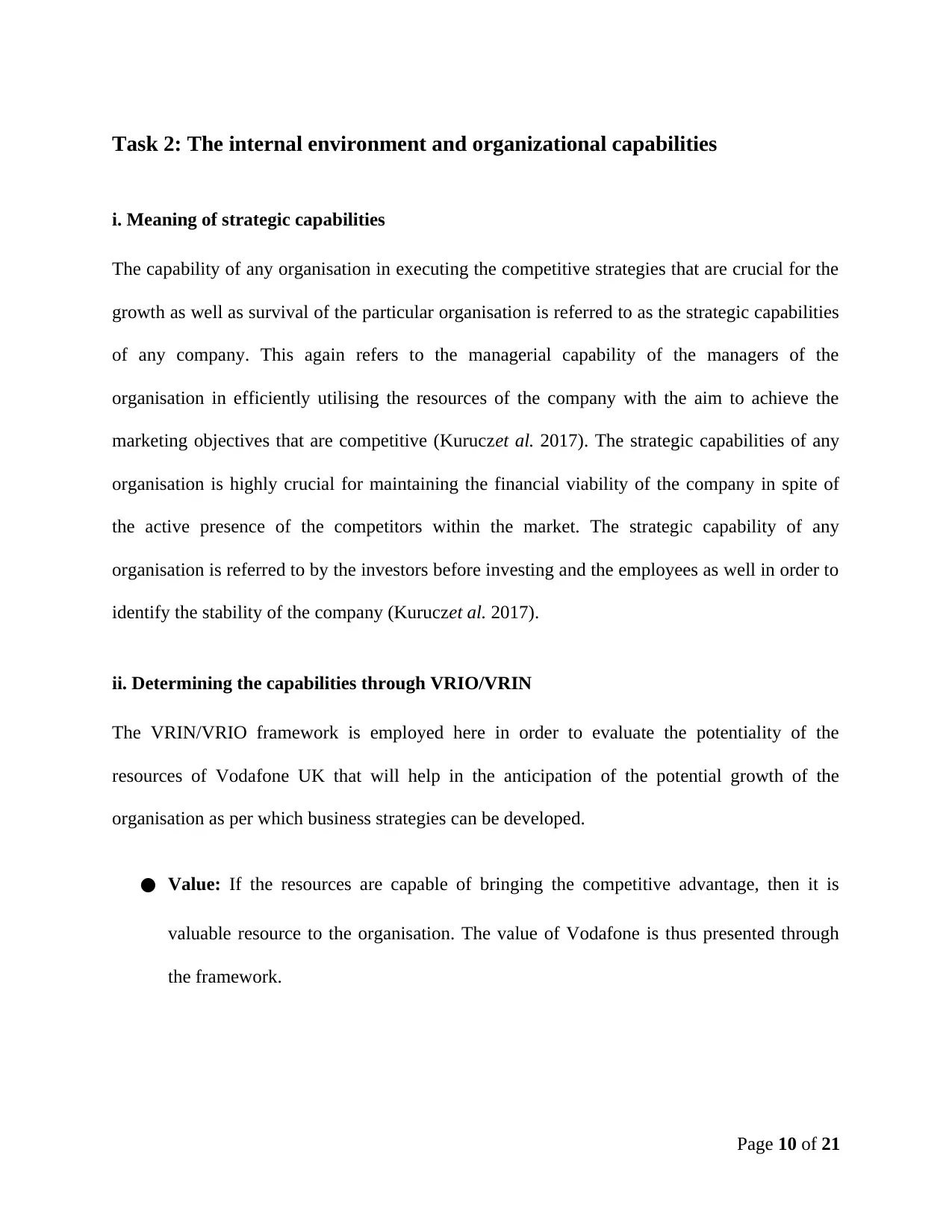
Task 2: The internal environment and organizational capabilities
i. Meaning of strategic capabilities
The capability of any organisation in executing the competitive strategies that are crucial for the
growth as well as survival of the particular organisation is referred to as the strategic capabilities
of any company. This again refers to the managerial capability of the managers of the
organisation in efficiently utilising the resources of the company with the aim to achieve the
marketing objectives that are competitive (Kuruczet al. 2017). The strategic capabilities of any
organisation is highly crucial for maintaining the financial viability of the company in spite of
the active presence of the competitors within the market. The strategic capability of any
organisation is referred to by the investors before investing and the employees as well in order to
identify the stability of the company (Kuruczet al. 2017).
ii. Determining the capabilities through VRIO/VRIN
The VRIN/VRIO framework is employed here in order to evaluate the potentiality of the
resources of Vodafone UK that will help in the anticipation of the potential growth of the
organisation as per which business strategies can be developed.
● Value: If the resources are capable of bringing the competitive advantage, then it is
valuable resource to the organisation. The value of Vodafone is thus presented through
the framework.
Page 10 of 21
i. Meaning of strategic capabilities
The capability of any organisation in executing the competitive strategies that are crucial for the
growth as well as survival of the particular organisation is referred to as the strategic capabilities
of any company. This again refers to the managerial capability of the managers of the
organisation in efficiently utilising the resources of the company with the aim to achieve the
marketing objectives that are competitive (Kuruczet al. 2017). The strategic capabilities of any
organisation is highly crucial for maintaining the financial viability of the company in spite of
the active presence of the competitors within the market. The strategic capability of any
organisation is referred to by the investors before investing and the employees as well in order to
identify the stability of the company (Kuruczet al. 2017).
ii. Determining the capabilities through VRIO/VRIN
The VRIN/VRIO framework is employed here in order to evaluate the potentiality of the
resources of Vodafone UK that will help in the anticipation of the potential growth of the
organisation as per which business strategies can be developed.
● Value: If the resources are capable of bringing the competitive advantage, then it is
valuable resource to the organisation. The value of Vodafone is thus presented through
the framework.
Page 10 of 21
Paraphrase This Document
Need a fresh take? Get an instant paraphrase of this document with our AI Paraphraser
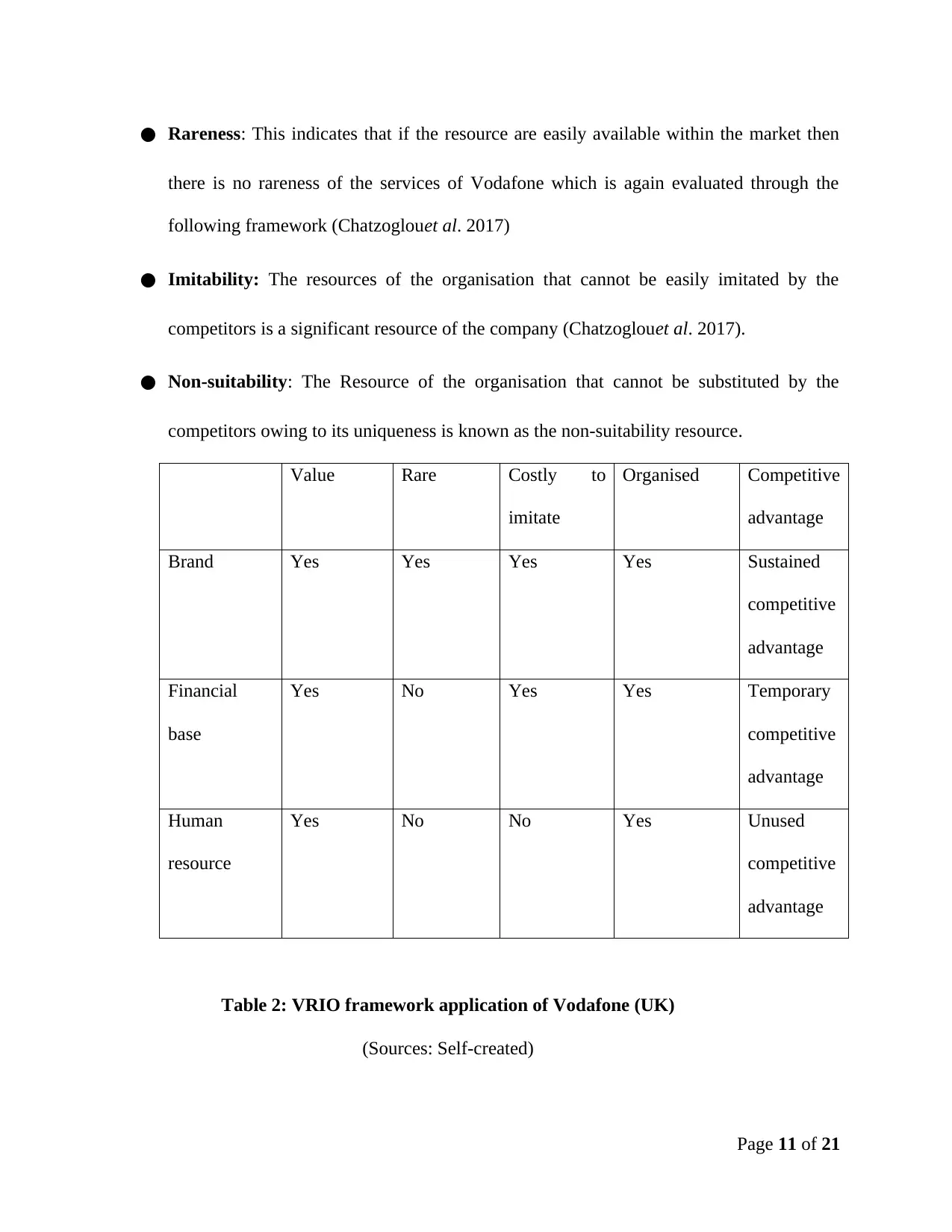
● Rareness: This indicates that if the resource are easily available within the market then
there is no rareness of the services of Vodafone which is again evaluated through the
following framework (Chatzoglouet al. 2017)
● Imitability: The resources of the organisation that cannot be easily imitated by the
competitors is a significant resource of the company (Chatzoglouet al. 2017).
● Non-suitability: The Resource of the organisation that cannot be substituted by the
competitors owing to its uniqueness is known as the non-suitability resource.
Value Rare Costly to
imitate
Organised Competitive
advantage
Brand Yes Yes Yes Yes Sustained
competitive
advantage
Financial
base
Yes No Yes Yes Temporary
competitive
advantage
Human
resource
Yes No No Yes Unused
competitive
advantage
Table 2: VRIO framework application of Vodafone (UK)
(Sources: Self-created)
Page 11 of 21
there is no rareness of the services of Vodafone which is again evaluated through the
following framework (Chatzoglouet al. 2017)
● Imitability: The resources of the organisation that cannot be easily imitated by the
competitors is a significant resource of the company (Chatzoglouet al. 2017).
● Non-suitability: The Resource of the organisation that cannot be substituted by the
competitors owing to its uniqueness is known as the non-suitability resource.
Value Rare Costly to
imitate
Organised Competitive
advantage
Brand Yes Yes Yes Yes Sustained
competitive
advantage
Financial
base
Yes No Yes Yes Temporary
competitive
advantage
Human
resource
Yes No No Yes Unused
competitive
advantage
Table 2: VRIO framework application of Vodafone (UK)
(Sources: Self-created)
Page 11 of 21
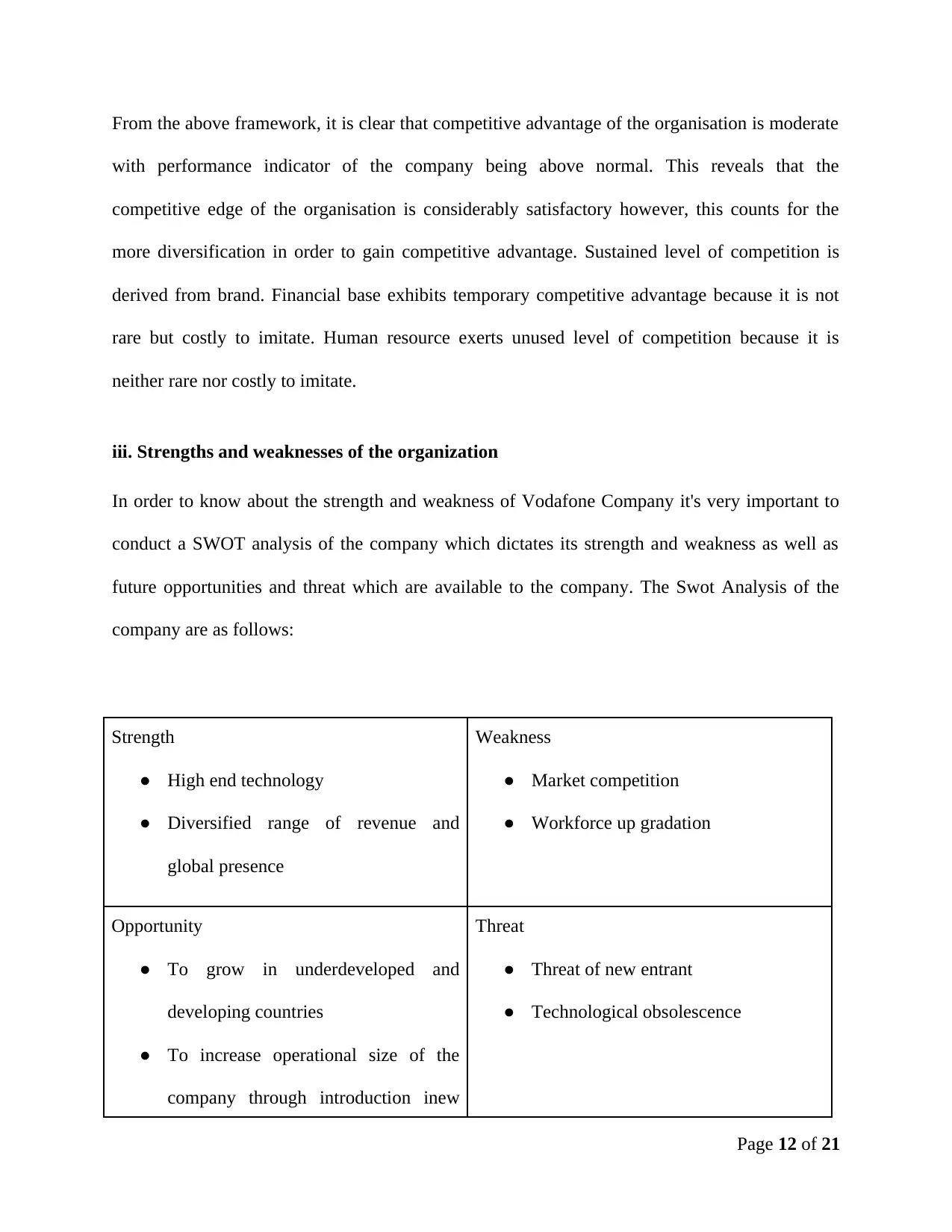
From the above framework, it is clear that competitive advantage of the organisation is moderate
with performance indicator of the company being above normal. This reveals that the
competitive edge of the organisation is considerably satisfactory however, this counts for the
more diversification in order to gain competitive advantage. Sustained level of competition is
derived from brand. Financial base exhibits temporary competitive advantage because it is not
rare but costly to imitate. Human resource exerts unused level of competition because it is
neither rare nor costly to imitate.
iii. Strengths and weaknesses of the organization
In order to know about the strength and weakness of Vodafone Company it's very important to
conduct a SWOT analysis of the company which dictates its strength and weakness as well as
future opportunities and threat which are available to the company. The Swot Analysis of the
company are as follows:
Strength
● High end technology
● Diversified range of revenue and
global presence
Weakness
● Market competition
● Workforce up gradation
Opportunity
● To grow in underdeveloped and
developing countries
● To increase operational size of the
company through introduction inew
Threat
● Threat of new entrant
● Technological obsolescence
Page 12 of 21
with performance indicator of the company being above normal. This reveals that the
competitive edge of the organisation is considerably satisfactory however, this counts for the
more diversification in order to gain competitive advantage. Sustained level of competition is
derived from brand. Financial base exhibits temporary competitive advantage because it is not
rare but costly to imitate. Human resource exerts unused level of competition because it is
neither rare nor costly to imitate.
iii. Strengths and weaknesses of the organization
In order to know about the strength and weakness of Vodafone Company it's very important to
conduct a SWOT analysis of the company which dictates its strength and weakness as well as
future opportunities and threat which are available to the company. The Swot Analysis of the
company are as follows:
Strength
● High end technology
● Diversified range of revenue and
global presence
Weakness
● Market competition
● Workforce up gradation
Opportunity
● To grow in underdeveloped and
developing countries
● To increase operational size of the
company through introduction inew
Threat
● Threat of new entrant
● Technological obsolescence
Page 12 of 21
⊘ This is a preview!⊘
Do you want full access?
Subscribe today to unlock all pages.

Trusted by 1+ million students worldwide
1 out of 20
Related Documents
Your All-in-One AI-Powered Toolkit for Academic Success.
+13062052269
info@desklib.com
Available 24*7 on WhatsApp / Email
![[object Object]](/_next/static/media/star-bottom.7253800d.svg)
Unlock your academic potential
Copyright © 2020–2025 A2Z Services. All Rights Reserved. Developed and managed by ZUCOL.




